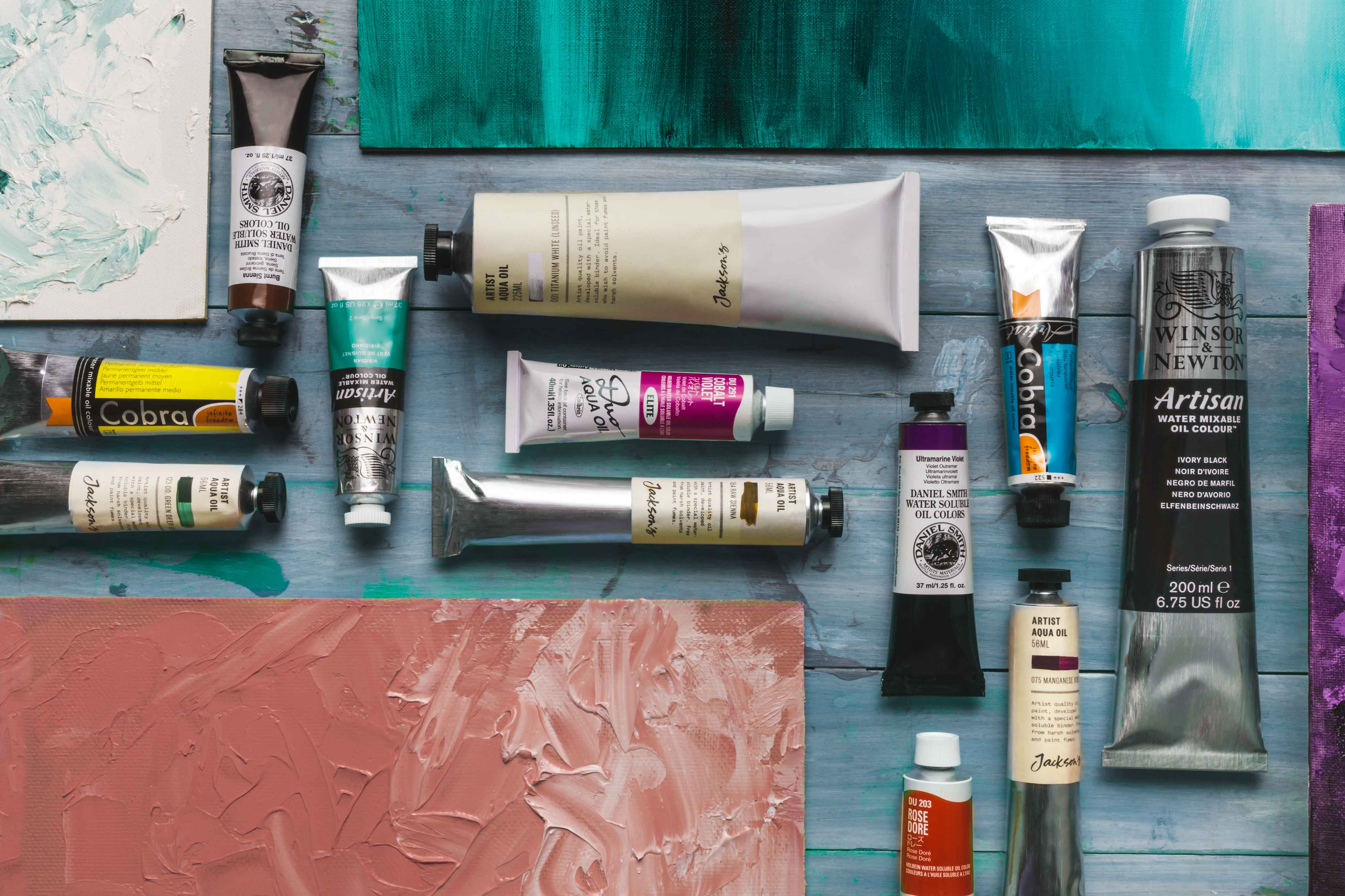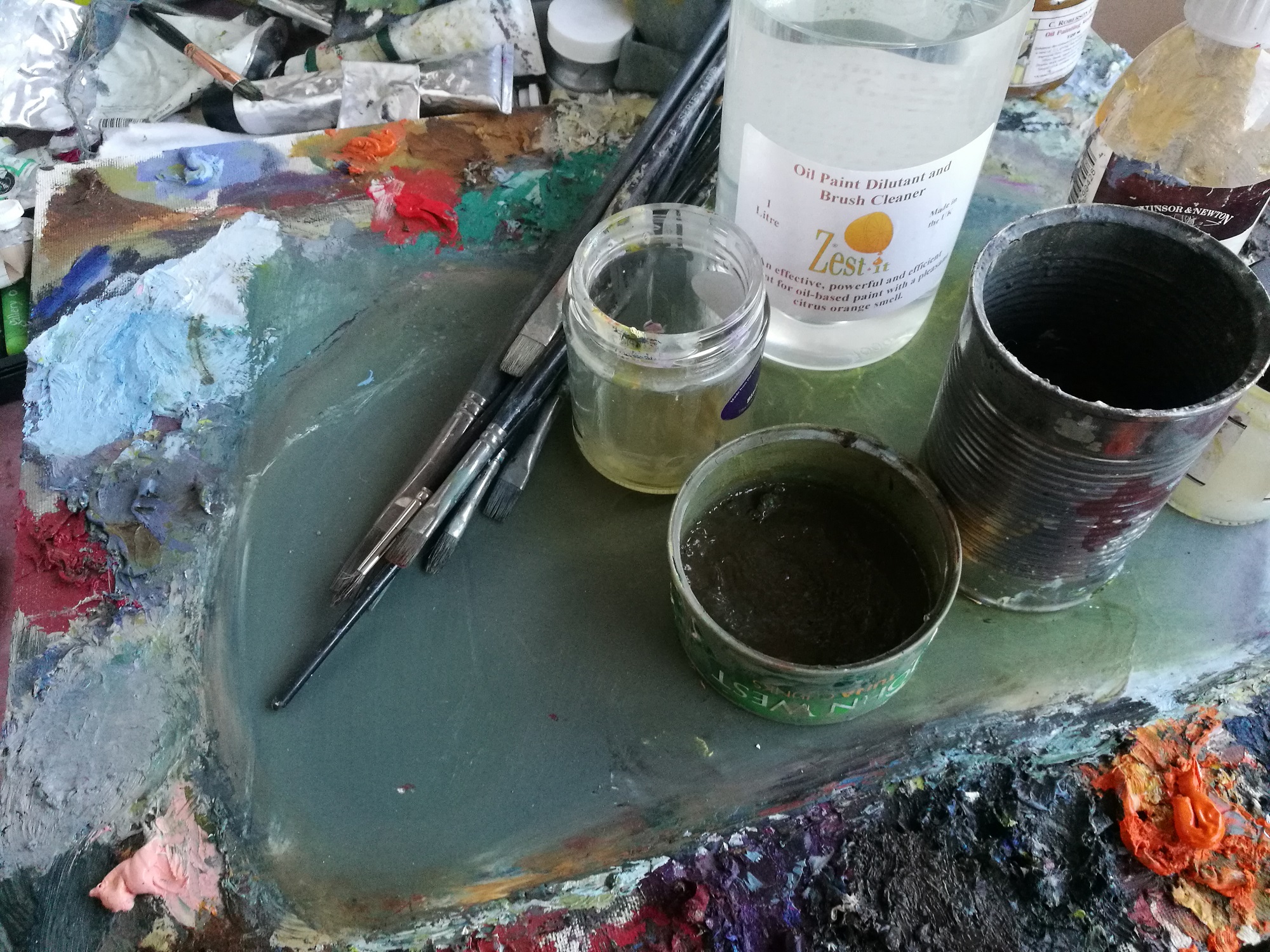How To Clean Oil Paint Off Paintbrushes
Traditionally, oil painting requires use of solvents (usually turpentine) to thin the paint and clean brushes. These solvents emit heady fumes which can cause headaches, and can dry your skin. In addition to this some of the pigments in oil paint possess an element of toxicity, and prolonged exposure to skin is not recommended. However you can make your oil painting session safer. Non-toxic thinners, water-mixable oil paints and barrier creams can all help to reduce contact with unpleasant solvents. Here are 5 simple steps you can take to make your oil painting session safer.

Water Mixable Oil Paints available at Jacksonsart.com
1. Painting with Water-Mixable Oils
There is little difference between the characteristics of traditional oil paint and water mixable oil paint. So it's possible to enjoy the lustre of oils without requiring solvents to thin paint or clean brushes. As the name suggests, water can be mixed to dilute your colour, and with a little soap brushes can be washed under a running tap.
Experienced oil painters may notice a little difference in the handling of the paint, but the differences tend to be very slight. You can read Julie Caves' water-mixable oil paint comparison post for an in-depth analysis of how they perform.
Water-mixable oil colour brands can be mixed with one another (and can also be mixed with regular oils, although of course they then lose their water miscibility). Daniel Smith, Cobra and Holbein Duo-Aqua all offer water mixable painting mediums in their ranges. By adding a fast drying painting medium or linseed oil, it's possible to extend your water-mixable oil paint. There are also fast drying mediums available.
You can use the same brushes and canvas that you would use for regular oil painting, and it would be useful to have some rags close to hand for blotting your brushes. The only difference in the process is exchanging a jar of solvent for a jar of water. No more heady fumes to give you a headache, no harsh solvents that dry your skin out, and no more respiratory issues either!
If you love a particular brand of oils and just don't want to change to water mixable alternatives, you might consider reducing the amount of solvent present in your painting sessions by using Gamblin non-toxic painting mediums. This post compares the Gamblin mediums with Liquin original.

Zest It Solvents and Cleaners
2. Zest-It and Low Odour Solvents
Zest-It is a non toxic, environmentally friendly alternative to regular solvent. It can be used instead of turpentine to clean your brushes and thin your oil paint. It has a strong (some might say artificial) citrus fragrance, but I strongly prefer it to the heady fumes of regular turps. If it wasn't for Zest-It Oil Paint Dilutant and Brush Cleaner I may not paint in oils at all. The safest low odour solvents such as Gamsol have had 99.95% of the most harmful aromatic solvents refined out of it, and are great for thinning alkyd paints.
Top Tip:
To get the most out of your Zest-It we suggest setting up a recycling system in your studio; When your jar of Zest-It starts to look a bit murky just put it to one side and start with another. Eventually all the gunk will sink to the bottom and you can pour the clear liquid into another vessel and keep on using it.
In comparison to regular solvents it is pricey, but using it in this way will help you get more for your money. The Zest-It company now produce a whole array of different products, including tailor made cleaners and painting mediums. Click here to browse the whole gamut!

My bottle of Zest-It is never far away from my trusty, rather worn palette!
3. Cleaning Brushes with Oil
Another way to avoid using solvents in the clean up operation following an oil painting session is to use oil. For cleaning, you can actually use vegetable oil from the supermarket, which will help keep costs down. Here's a great cleaning routine for your brushes:
- Blot the excess paint from your brushes on to a rag or some old newspaper.
- Dip them into a little oil and work the oil into the bristles with your fingers. This will help to get any further paint from your brush.
- Blot and repeat until there is no more paint coming out.
- Finish the clean-up operation by washing with soap and water. You can use regular soaps but the artist's soaps available such as The Master's Brush Cleaner and Preserver contain natural oils that help keep your tools in great condition.
- Once your brushes are clean the best thing to do is hang them up by their handles so that any moisture is able to run out of the brush head and not sit in it and cause it to rot.
Your painting palette can be cleaned in a similar way, and if it's wooden will actually last longer if you clean it with oil rather than solvent. Scrape the paint from your palette using a palette knife, wipe the remaining excess paint away with an old rag, and then clean the rest away by pouring a bit of oil on the surface and wiping with another rag. The oil will prevent your wooden palette from drying out.

This trusty plastic 'garden' water bottle is regularly filled up with vegetable oil, and makes light work of cleaning away oil paint, without the need for solvents
4. Avoiding Contact with Oil Paints
If you have sensitive skin or are prone to respiratory issues, you may find that oil painting mediums and solvents can only worsen the issue. Largely this is due to the solvents contained in these products, which can emit heady fumes as well as dry your skin.
Additionally, pigments have varying degrees of toxicity, and once the solvents have dried the skin out, it's not healthy to expose the skin to pigments that can seep into the skin. Sensibly, many of the most toxic pigments are no longer used in oil paint manufacture and have been replaced with safer alternatives. So while there isn't as great a health risk as there once was, it's still wise to take precautions when handling the more toxic pigment – such as lead, cobalt and cadmium paints.
It's a good idea to wear nitrile gloves or barrier cream when painting, especially if you have sensitive or dry skin conditions. Oil paint can be hard to scrub off completely and pigments can remain in contact with your skin way beyond your painting session is over.

Winsor and Newton Art Guard Barrier Cream
I personally dislike using nitrile gloves because they make your hands get sweaty very quickly, however they're probably the safest option for the most delicate skin types. Art Guard barrier cream would be my go-to product. It can feel a bit greasy but a layer of this cream will make it really easy to wash the paint off after a painting session.
Alternatives to Barrier Cream or Latex Gloves
If you choose not to use Barrier Cream or Nitrile Gloves you may spend considerable time with a scrubbing brush on your hands, or you could try using Swarfega (gritted soap). You could also try working the paint away from your hands with an oily substance such as vegetable oil, moisturiser or even smooth peanut butter! These have all proven to help remove paint.
5. Good Ventilation
If you cannot avoid using solvents (and even if you can!) it's always a good idea to paint in a well ventilated space. Have a window or 2 open to allow for air and any fumes to circulate. The use of low odour solvents can help with reducing the potential for headaches, but ventilation is still an extremely good idea, as they do still emit fumes as regular solvents do, that are not healthy to breathe in.

It's always a good idea to let a little fresh air into your studio when painting in oils
Lisa Takahashi has been a contributor to the blog since 2013 and a Jackson's team member since 2006. Her love of art materials spans oils, watercolours, acrylics and relief print techniques. Alongside her writing she regularly exhibits her artwork, and teaches linocut and painting in Bristol and Somerset.
How To Clean Oil Paint Off Paintbrushes
Source: https://www.jacksonsart.com/blog/2018/04/04/5-steps-to-safer-oil-painting/
Posted by: wenzelsymbeentere.blogspot.com

0 Response to "How To Clean Oil Paint Off Paintbrushes"
Post a Comment